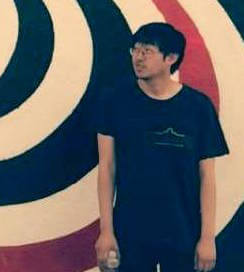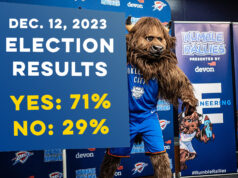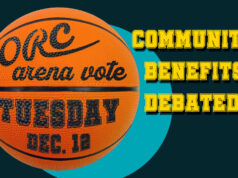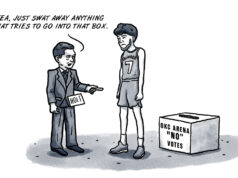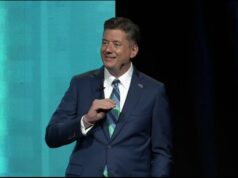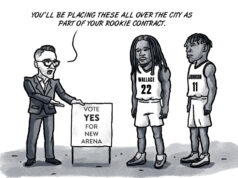Jermaine O’Neal entered the NBA in 1996 and left the league in 2016. Far removed from his all-star days with the Indiana Pacers but not officially retired from the league, O’Neal is spending his summer with Ice Cube’s BIG3, a business experiment that sometimes feels more like a traveling basketball festival than a proper professional tournament.
If you go to BIG3’s first Oklahoma event Sunday, July 9, in Tulsa, the full-blown rap concert at halftime will help you understand what this league offers: entertainment without pretention. Think competitive sports without 24-hour stat tracking and conjecture.
“We ain’t signing up for it to be a clown show,” O’Neal told TMZ Sports in March.
The BIG3 promotes three-on-three basketball with two reserve players on the bench to round out the five-person roster. The eight teams aren’t chained to cities, and neither is the league. During the course of 10 weeks, the BIG3 will travel across the United States. Sunday’s week-three performances will be at Tulsa’s BOK Center.
The worn knees and ankles of inactive or retired NBA superstars have carried the BIG3 thus far, though they suddenly appear spryer than you might have imagined. Watching O’Neal on day one repeatedly post up his man with brute strength for easy buckets was a sight to see. And it made me realize that yesterday’s superstars aren’t the only things missing from today’s NBA.
BIG3 has open lane to the basket
During this year’s NBA finals, commentator Jeff Van Gundy lamented on-air that the NBA prioritizes enforcing certain rules over others to make its product more aesthetically pleasing. Van Gundy revealed his theory after watching a Warriors player hack a Cavs player in the post without consequence, which was juxtaposed with smaller Warrior players navigating tiny open lanes unmolested for beautiful finishes courtesy of strict modern no-hand-checking mandates.
Van Gundy said it was the league’s way of telling players how it wanted them to play. In this regard, if the BIG3 can offer anything the NBA can’t, it’s overall physicality. Just ask dribbling wizard Jason Williams, who incurred a week-one injury that will keep him off the court for the next six to eight months. Ask Corey Maggette, the former Clipper’s star who also suffered a season-ending injury in game one. I’m not sure if anyone could’ve imagined this type of competitive fire from a three-on-three half-court basketball game. At least, I didn’t.
“Nobody wants to lose, and you can just tell everyone is into it,” Rashard Lewis, a two-time NBA All-star who is also committed to Ice Cube’s latest venture, told UPROXX recently.
The BIG3 also isn’t built off of one star player. Many members of the media wrote negative articles about Allen Iverson’s performance thus far. He’s been the face of league since the BIG3’s first press conference. Though he might have been the league’s initial draw, it’s a positive sign for the league’s overall future health how people are reacting to the games amid his slump. Spending a large portion of the time on the sidelines coaching, Iverson’s scored four points in two games in front of two fairly large crowds: 15,177 then 10,651.
Former NBA stars might be the BIG3’s only connection to the NBA, but that hasn’t stopped this basketball oddity from crossing storylines with its mainstream brethren. Chauncey Billups, the former Detroit Piston’s great, was set to play in week one of the BIG3’s schedule until his name got tangled in the Cleveland Cavaliers’ general manager drama as a candidate to replace David Griffin. He finished week two with 15 points, which isn’t bad for a guy who took his name out of the running for Cleveland’s top front office positions hours later.
BIG3: Basketball in a vacuum
There’s something soothing about this version of basketball. The games feel less frantic. My eyes aren’t bouncing back–and-forth trying to keep up with the NBA’s addictive but frenetic pace. Looking at the BIG3’s sectioned-off court, it almost feels like I’m watching a tennis match on a Sunday afternoon, where the crowd goes, “Ohhhh” appropriately at plays but remains generally less noisy than patrons at a Friday night NBA game. In this sense, the BIG3 is basketball for basketball’s sake: a place for hardcore fans to relax. It’s basketball in a vacuum, where people don’t necessarily have to get wrapped up in stakes and legacies as they appreciate the game for what it is.
Oddly enough, the BIG3 also reminds me of Arena Football, and I don’t mean that pejoratively at all. When you take apart each league’s rule set, you can see how smart adjustments were made to maximize their products. It’s as if some people realized that there were good athletes on the market that needed something to do and figured out what type of playing field would best showcase those talents while also differentiating the product from the dominant leagues in their respective sports. These people also picked the perfect cities to host their shows.
So one more reminder: The BIG3 is heading to Tulsa on July 9, which I think is another intelligent marketing decision. Tulsa has had its share of basketball envy since the Oklahoma Hornets, which has probably only grown in the Thunder era. Maybe it’s time for me to envy Tulsa a little bit. I wouldn’t mind making the drive to see a little Sunday-afternoon hoops and remember what made me love this sport in the first place.









